FORT DESOTO IPT REPORT
MORE ON GITZO CF TRIPOD MAINTENANCE
FOR THE LAST TIME A: 500 OR 600?
FOR THE LAST TIME B: IS ON OR OFF?
Photo Theme: images from the recent Fort DeSoto IPT.
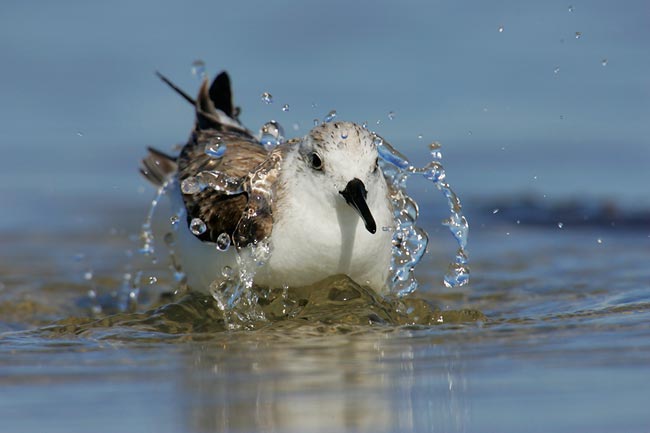
Sanderling, winter plumage bathing, Fort DeSoto Park, Tierra Verde, FL
Image copyright 2005: Arthur Morris/BIRDS AS ART
Canon 600mm f/4 L IS lens with 2X II TC and EOS 1D Mark II on Panning Ground Pod:
On afternoon high tides, East Beach can be extremely productive. You can photograph either from your car or, as here, on your belly.
To learn more about photographing at Ft. DeSoto, consider our DeSoto/Sarasota Site Guide:
Many DeSoto and Sarasota spots will be excellent for the next few months.
FORT DESOTO IPT REPORT
I just got back from the Fort DeSoto IPT and am headed to Texas for a few weeks to present at the Edinburg Nature Photography Festival (see Bulletin 167 for details). Despite the fact that Hurricane Charlie negatively affected photography at Fort DeSoto the IPT was a huge success with lots and lots of tame birds and lots of learning going on. Most of the 13 folks who attended were from Florida but we did have folks from Missouri, Arizona, New York. It stormed on Saturday morning so we conducted a mini-Photoshop Seminar for three plus hours and everyone was thrilled to learn about my fast and effective workflow and even experienced users picked up several valuable tips. (If you would like to see what the folks were so excited about, visit: http://www.birdsasart.com/digitalbasics.htm)
The Laughing Gulls in the spectacular breeding plumage were plentiful and they performed a variety of courtship behaviors as advertised. There were fewer courting Royal and Sandwich Terns but there were many hundreds of migrating Forster's and Common Terns and several folks killed on a drop-dead gorgeous Caspian Tern on Sunday afternoon. On Saturday afternoon we had several Least Terns at East Beach. The shorebirds at East Beach and North Beach were plentiful and cooperative. Pretty much everyone got to photograph Willet, Black-bellied Plover, Least and Western Sandpipers, Wilson's, Semipalmated, and Piping Plovers, Short-billed Dowitcher, Dunlin, American Oystercatcher, Marbled Godwit, and Long-billed Curlew. The tall waders were noticeable by their scarcity. We did have a cooperative Reddish Egret and a cooperative Great Blue Heron, a killer Great Egret that caught several fish on Saturday afternoon, and a Tricolored Heron that followed the feeding female Red-Breasted Mergansers over great distances.
The highlights of the trip were several pairs of Laughing Gulls and Royal Terns that courted in the clear, a few pairs of displaying Sandwich Terns, and many, many opportunities to photograph various species bathing. We reviewed the sequence of expected bathing behaviors and went over a variety of photographic techniques designed to improve the odds of capturing a spectacular image of the aprhs-bath wing flap. Ooops, I almost forgot the five Roseate Spoonbills that flew in just before dusk on Friday. As almost always, the IPT group consisted of lovely, like-minded folks interested in learning to make better images and many new friendships sprouted. The dates for next year's DeSoto/Sarasota IPT will be announced in late April.
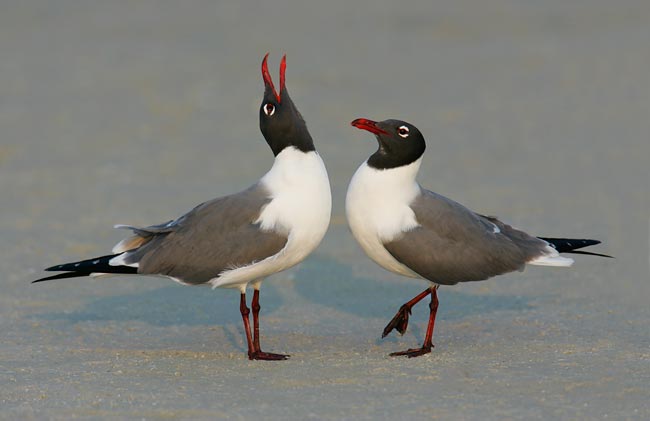
Laughing Gulls, courting pair, Fort DeSoto Park, Tierra Verde, FL
Image copyright 2005: Arthur Morris/BIRDS AS ART
Canon 600mm f/4 L IS lens with EOS 1D Mark II.
This was the very first image that I made on the IPT. I will always be fascinated by the beauty and variety of courtship behaviors performed by the gulls and terns. So many times they go through their age-old rituals while surrounded by other birds, so catching a pair in the wide open is always a thrill. Here, I selected an AF sensor just to the left of center to make the image.
MORE ON GITZO CARBON FIBER TRIPOD MAINTENANCE
Several folks wrote calling me to task for suggesting that it is OK to clean the Gitzo Carbon Fiber tripods with turpentine. We actually use mineral spirits and believe that that is the solvent that Bogen recommended to me some time ago. The folks who wrote suggested using isopropyl alcohol or WD-40 as cleaning solvents...
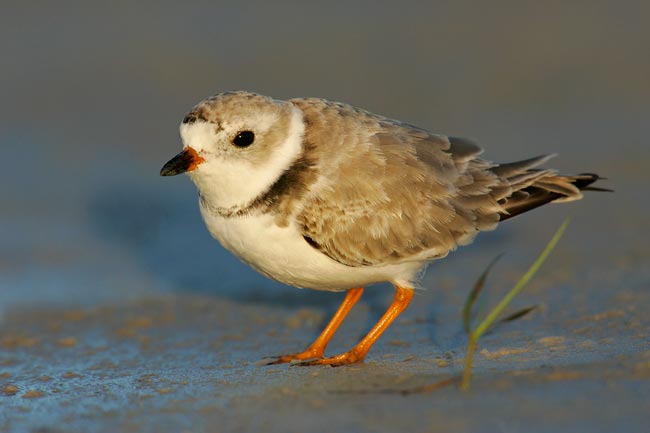
Piping Plover, Fort DeSoto Park, Tierra Verde, FL
Image copyright 2005: Arthur Morris/BIRDS AS ART
Canon 600mm f/4 L IS lens with 2X II TC and EOS 1D Mark II on Panning Ground Pod:
In the Art of Bird Photography, I wrote, "Add green whenever possible." Following my own advice here helped me to create this image.
The tiny stalk of grass made this one my favorite from a long series of similars.
FOR THE LAST TIME A: 500 or 600?
Many folks write asking if they should purchase the Canon EF 500mm f/4 L IS lens or the EF 600mm f/4 L IS lens. The 500mm is much lighter, costs less, focuses closer, and is easier to travel with. It is easier to use in the car, easier to use on the ground, and can be handheld for flight or action for short periods of time. The 600mm is heavier, costs more, has a longer minimum focusing distance, is brutal to carry for long distances, and is difficult to travel with. The size of the bird in the frame (as measured by the area covered by the subject) in images made by the 600mm will, however be 44% larger with the 600 than with the 500. This ratio is the same whether using the prime lenses alone or with either teleconverters. I do recommend that folks eager for the extra focal length advantage actually lift a 600 with a Mark II and a Wimberley head mounted on a Gitzo 1325 tripod before plunking down their credit card.
As I approach my 59th birthday, I would, if I could own only one of the above lenses, choose the 500mm in a heartbeat.
(Note for Nikon users: The above advice would not apply to Nikon users choosing between the Nikon 500 and 600mm lenses because the IS advantage is not available at present. Folks using the Canon 500mm can learn to make sharp images routinely at the 1000 mm focal length--the lens plus the 2X II TC. Thus, Nikon folks serious about photographing birds would be more likely to opt for the 600mm. Do note that the high-end Nikon 600mm is lighter than the Canon 600mm f/4 L IS lens.)

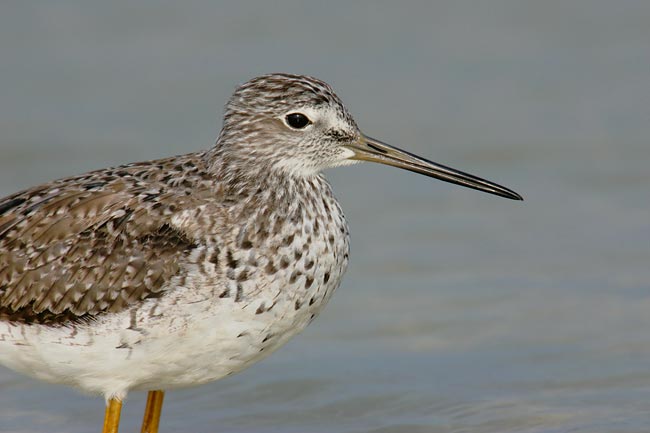
Greater Yellowlegs beginning to molt into breeding plumage, Fort DeSoto Park, Tierra Verde, FL
Images copyright 2005: Arthur Morris/BIRDS AS ART
Both images were made with the Canon 600mm f/4 L IS lens and the EOS 1D Mark II.
The top image was created with the prime lens alone, the lower image with the 2X II TC added to the mix.
Both images were made from the exact same position. I made the tighter image below first, then took off the TC and created the image featuring the whole bird. I like the top image best.
Shorebird migration will be peaking thoughout North America during the next two months. To learn more about my favorite bird family, consider getting a signed copy of my Shorebirds: Beautiful Beachcombers: http://www.birdsasart.com/books.html#SHOREBIRDS
FOR THE LAST TIME B: IS ON OR OFF?
Many folks, confused by statements in various Canon user guides and manuals, write asking if IS should be turned off when using various lenses on a tripod. Here is the advice given by Canon's top US Tech-Rep, Chuck Westfall:
The EF Image Stabilizer lenses listed below support "tripod IS." The IS switch may be left in the on position when using these lenses on tripod.
EF28-300mm f/3.5-5.6L IS USM
EF70-200mm f/2.8L IS USM
EF70-300mm f/4.5-5.6 DO IS USM
EF300mm f/2.8L IS USM
EF400mm f/2.8L IS USM
EF400mm f/4 DO IS USM
EF500mm f/4L IS USM
EF600mm f/4L IS USM
EF28-300mm f/3.5-5.6L IS USM
EF70-200mm f/2.8L IS USM
EF70-300mm f/4.5-5.6 DO IS USM
EF300mm f/2.8L IS USM
EF400mm f/2.8L IS USM
EF400mm f/4 DO IS USM
EF500mm f/4L IS USM
EF600mm f/4L IS USM
(Editor's note: Chuck told me some time ago that (except when photographing a static subject from a moving vehicle) IS 2 Mode performs exactly the same as IS 1 mode when any of the lenses above are mounted on a tripod. For that reason, I set the IS Mode for these lenses on Mode 2 and for all intents and purposes never set it to Mode 1.
The EF Image Stabilizer lenses listed below do not support "tripod IS." The IS switch should be in the off position when using these lenses on a tripod.
The EF Image Stabilizer lenses listed below do not support "tripod IS." The IS switch should be in the off position when using these lenses on a tripod.
EF28-135mm f/3.5-5.6 IS USM
EF75-300mm f/4-5.6 IS USM
EF100-400mm f/4.5-5.6L IS USM
EF300mm f/4L IS USM
(Editor's note: when hand-holding any of the four lenses above, it is best to set IS 1 mode when photographing static subjects and IS 2 Mode when photographing subjects in motion.)
For a more extensive explanation of tripod on or off, see the thread here: http://www.robgalbraith.com/ubbthreads/showflat.php?Cat=&Board=UBB18&Number=220915

Laughing Gulls, courting pair, Fort DeSoto Park, Tierra Verde, FL
Image copyright 2005: Arthur Morris/BIRDS AS ART
Canon 500mm f/4 L IS lens with EOS 1D Mark II.
On the morning after the IPT, I headed back to North Beach and discovered that on clear, still mornings the main lagoon reflects the pinks and purples in the pre-dawn sky opposite the sunrise.
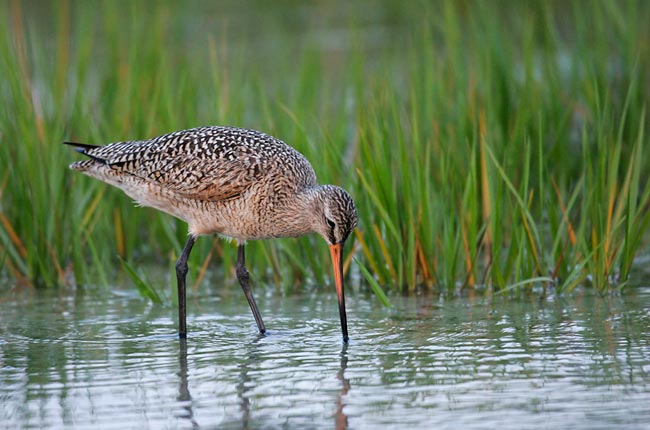
Marbled Godwit in breeding plumage, Fort DeSoto Park, Tierra Verde, FL
Image copyright 2005: Arthur Morris/BIRDS AS ART
Canon 600mm f/4 L IS lens with EOS 1D Mark II. ISO 800.
Before last Saturday, the only Marbled Godwits that I had ever seen with the orange-based bills of breeding plumage in my 29 years of shorebirding had been those that I saw on a May trip to Montana many years ago. Wintering birds of this species usually have pink-based bills. ISO 800 images made with the Mark II exhibit very little noise.
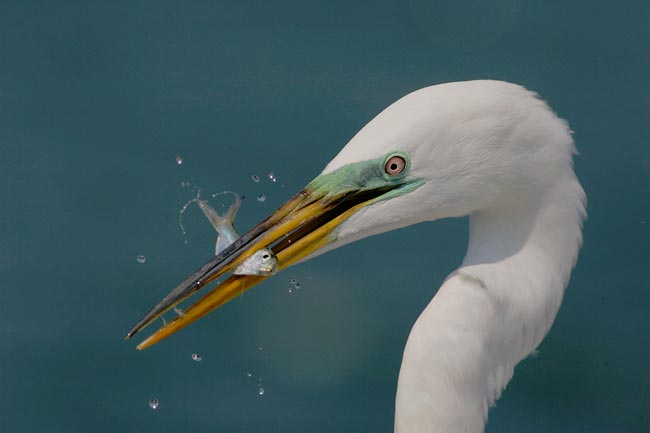
Great Egret, North Skyway Fishing Pier, St. Peteresburg, FL
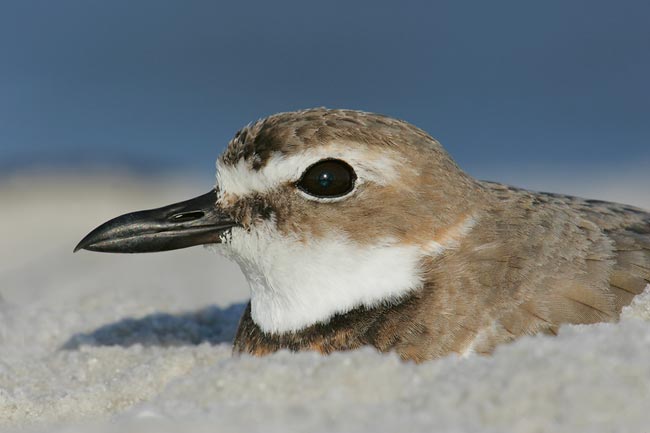
Image copyright 2005: Arthur Morris/BIRDS AS ART
Canon 400mm f/5.6 L lens handheld with the EOS 1D Mark II.
When things slowed down on the first IPT morning, we zoomed over to the pier and had some great fun.
AFPS (45-point) AF made capturing this image as easy as pie.

Wilson's Plover, Fort DeSoto Park, Tierra Verde, FL
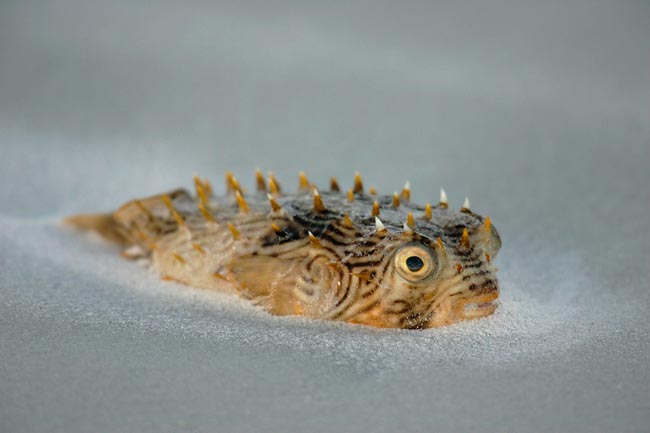
Image copyright 2005: Arthur Morris/BIRDS AS ART
Canon 600mm f/4 L IS lens, 2X II TC, two 25mm extension tubes, and EOS 1D Mark II on Panning Ground Pod.
For extreme close-ups, put the extension tubes on the lens and the TC on the camera. You lose autofocus but gain almost two feet of additiional close focus.

Blowfish, expired, half buried in sand, Fort DeSoto Park, Tierra Verde, FL

Image copyright 2005: Arthur Morris/BIRDS AS ART
Canon 600mm f/4 L IS lens with 25mm extension tube and EOS 1D Mark II.
Creative vision involves walking around until you find something that interests you.
After that, you decide on a perspective and the right tools... This was not my first choice, but I worked the subject and this one wound up being my favorite.
With the 17+ foot minimum focusing distance of the 600 IS, you do not want to leave your extension tubes in the car!

Laughing Gull, after bath flap, Fort DeSoto Park, Tierra Verde, FL
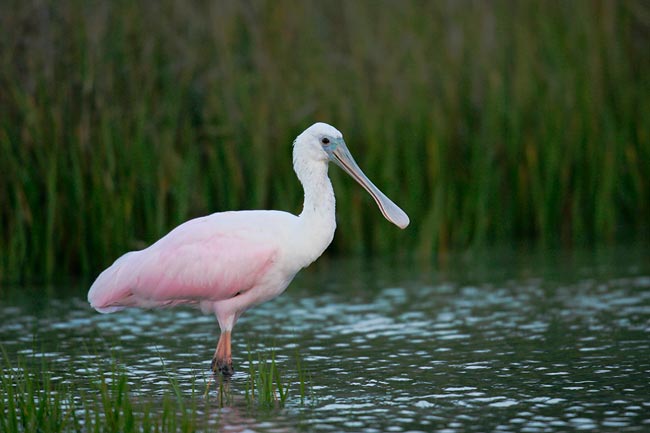
Image copyright 2005: Arthur Morris/BIRDS AS ART
Canon 400mm f/5.6 L lens handheld with the EOS 1D Mark II.
When attempting to capture the flap aftter the bath, the most important thing is to work wide enough to ensure that you will not clip the wings...

Roseate Spoonbill, immature, Fort DeSoto Park, Tierra Verde, FL
Image copyright 2005: Arthur Morris/BIRDS AS ART
Canon 600mm f/4 L IS lens with EOS 1D Mark II. ISO 800.
The immature spoonbills have white heads and blue lores. They lack the carmine slash on the wings. The combination of pink and green is an attractive one.
Best, and love and great picture-making to all,
Artie
Artie
Note: Arthur Morris has been a Canon contract photographer since 1994 and continues in that role today. Hunt's Photo of Boston, MA is a BIRDS AS ART sponsor, as is Delkin Devices. Do feel free to forward this Bulletin to one or more photographer-friends. Those wishing to subscribe click here: mailto:http://birdsasart.us1.list-manage.com/subscribe?u=94ad23bd96f48a1de2ca612b3&id=bdb4a511a0?subject=subscribe To unsubscribe, click here: mailto:birdsasart@verizon.net?subject=unsubscribe. Back issues of all BAA Bulletins and relevant BAA Notes are archived on the web site at: http://www.birdsasart.com/bn.html